Extract from The Guardian
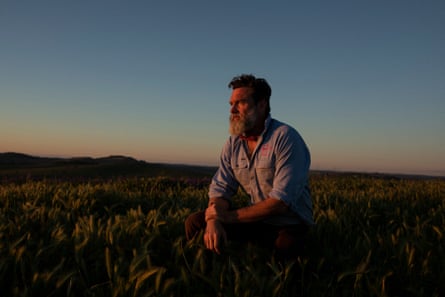
It’s the omnivore’s dilemma: is there an environmentally responsible way to continue eating meat? Cattle farmers like Charlie Arnott are working on a fix
Last modified on Thu 17 Sep 2020 03.56 AEST
“I would see paddocks blowing away in the wind,” laments pastoralist Charlie Arnott, as if confessing a crime. “That was confronting. Did I make that happen? Did decisions I make allow that topsoil to blow away?”
It was about 15 years ago, as the Millennium drought baked the life out of his farm in Boorowa, south-west of Sydney, that Arnott resolved to put a stop to the gusts of dirt being lost to the sky.

When drought returned in recent years, Arnott and a growing collection of sustainability-minded pastoralists were better prepared for the challenge – and so was the soil beneath their feet.
“The topsoil blowing away was the symptom, but the actual problem was the way I was grazing,” Arnott says. “I loved my cattle more than I loved my grass.”
Instead of spreading his Shorthorn cattle out across his 2,000-odd hectares of land, these days Arnott keeps the livestock together in larger groups and rotates them through pastures.
The idea is
to let their manure fertilise the soil and their hooves churn up the
ground to create divots for new growth, before the pasture is left for
an extended period to regenerate.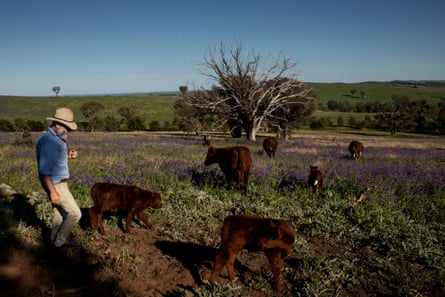
“In nature you don’t have animals stuck in one place to just chew, chew, chew for months on end,” he says. “This way grass gets to express its grassness, and becomes healthier and tougher.”
He went “cold turkey” and stopped bathing the animals and land in chemicals, instead seeking to address the root cause of pests and taking advantage of what weeds can offer, such as softening up hard soil.
Arnott planted trees across his property, which in turn provided shade for cattle, mulch for the land and windbreaks to safeguard his dirt.
He believes his new approach has helped preserve grass cover through the latest drought, and assisted the land in retaining water in the rains that finally broke earlier this year.
Arnott is particularly adamant on the environmental and cost advantages of grass-fed cattle over those fed grain in feedlots.
“When you look at the feedlot situation, it is carbon intensive in terms of transporting the grain there, arguably the quality of meat is not as good, and there’s the ethical side too [of the cattle having more room to move on pasture],” he says.
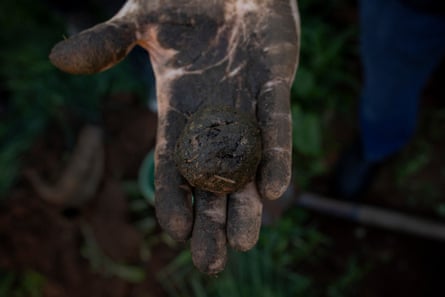
A 2019 survey supported by the Australian government’s National Environmental Science Program and a range of universities that indicated regenerative agriculture operations yielded between 13%-16% more grass cover relative to nearby conventional farms during dry years, as well as greater profitability and improved farmer wellbeing.
Healthier soils also serve as a carbon sink, providing at least a partial offset of the emissions generated by methane-belching cattle.
Seeking a social licence
The livestock sector is scrambling for such solutions as it seeks a social licence to continue operation in a carbon-constrained economy.
The Food and Agriculture Organisation of the United Nations has warned that livestock generate 14.5% of all anthropogenic greenhouse gas emissions. In 2019, the Intergovernmental Panel on Climate Change urged consumers to greatly reduce their meat consumption in order to tackle the climate crisis.
Last month, Australia’s National Farmers Federation threw conditional support behind an economy-wide target for net zero emissions by 2050. Meat & Livestock Australia is aiming for carbon neutrality by 2030.
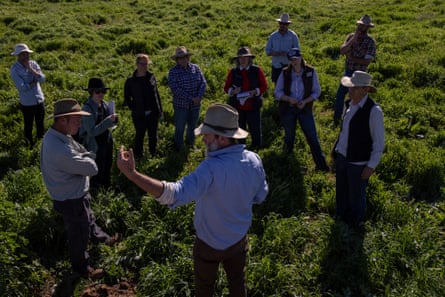
The National Farmers’ Federation chief executive, Tony Mahar, says regenerative agriculture is a key part of the sector’s plans to reduce emissions, and that the organisation is lobbying the federal government to introduce a market-based scheme to reward farmers for undertaking sustainable land management practices.
A $4m federal grant will fund a trial of the NFF’s proposal next year.
The grant came out of the $34m agriculture stewardship package, which a spokesperson for the federal department of agriculture said is also supporting the Australian National University’s development of a reporting verification framework for on-farm biodiversity.
In response to a question as to why the federal government was not mandating zero carbon targets for agriculture and the meat industry, the spokesperson said Australia is pursuing “emissions reduction targets that are achievable, responsible and balanced”.
Farmers for Climate Action chair Lucinda Corrigan says the NFF backing of an economy-wide zero carbon target for 2050 is a “good start”, but warns that it is not ambitious enough to head off climate change that threatens to cripple Australian food production.
Her organisation is pushing a five-year, $1.8bn plan for regional areas to bounce back from the Covid-19 recession through measures including investment in regenerative agriculture, and improving carbon stocks in agricultural lands.
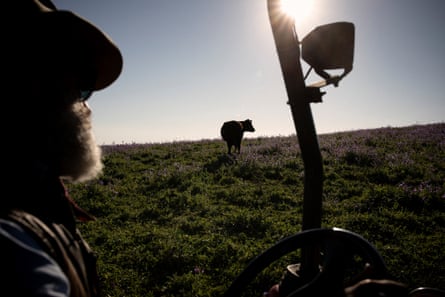
Corrigan says that realistically the livestock sector will in most cases be offsetting their own emissions rather than profiting from a net carbon saving.
She says the plan also pushes for greater investment in technological innovation, pointing to CSIRO development of a red algae feed that could reduce the methane emitted by cows by as much as 80%, as an example of what can happen when scientists collaborate with farmers.
Corrigan also cites the example of her own family’s Angus cattle genetics business, which is seeking to breed varieties that mature faster and therefore emit less over their lifetimes.
The Corrigan family planted 100,000 trees around the enterprise’s properties in the Murray Valley between Albury and Holbrook, the kind of initiative she says biodiversity incentives could encourage at livestock operations all over the country.
“Trees offer
co-benefits besides shade and reducing erosion on farm – such as
protection of birds, provided you plant the right trees for nectar,” she
says.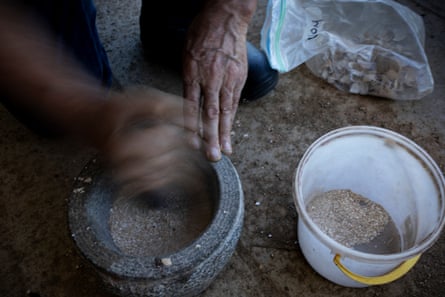
She also points to the potential of perennial grass varieties that grow throughout the year, like native kangaroo grass, to increase water retention and survive droughts.
“What we see above ground we will see below ground,” he says. “Shorter plants will have shorter roots, and be more vulnerable to climate change and drought.”
Kahn says there are a range of challenges when providing incentives to farmers to undertake land management, including figuring out how not to reward past bad behaviour.
“Land managers who have already invested through better tree cover through generations, well the current proposed schemes only reward additionality,” he says. “Reward systems tend to be targeted toward the bottom rather than the top, so if you’ve poorly managed your land before you’d get rewarded.”
A simple solution?
As the livestock industry explores technological solutions and regenerative practices, climate scientists and sustainability experts note that the most straightforward way for people to reduce their dietary carbon footprint is to simply stop eating so much meat.
But urging moderation is not on the agricultural sector’s agenda.
Mahar
says dietary choices should be left up to consumers, and that the NFF
“wouldn’t support measures that actively reduce meat consumption”.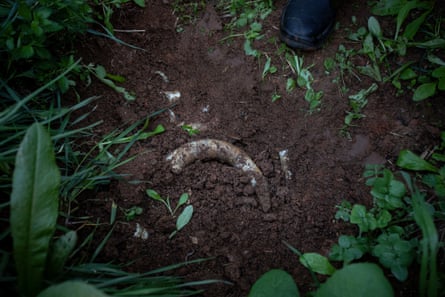
Heart Foundation guidelines set a recommended limit of 350 grams of unprocessed beef, lamb, pork and veal a week. According to the latest Organisation of Economic Development and Co-operation figures, Australians consume close to 900 grams of beef, pork, veal and sheep meat a week on average per capita.
Back at his Boorowa paddock, Charlie Arnott is also not keen on the idea of people eating less meat, and is convinced there is a viable path forward if each landholder manages their turf appropriately.
“As farmers, we’ve helped create the problem, but we hold the tools to turn it around,” he says.
But environmental science expert Dr Michalis Hadjikakou from Deakin University says regenerative farming practices will only be effective if we do cut back.
“We are consuming too much meat in western countries… to provide that much in a regenerative way,” he says. “If we reduce the amount of meat we eat, then we can get it through regenerative practices.”
Hadjikakou, who is undertaking a literature review of regenerative agriculture to better understand which practices are backed by science, warns that there are tradeoffs to consider for livestock reared through such systems.
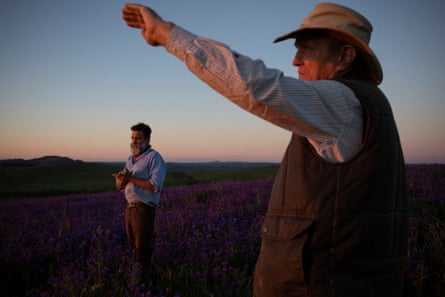
While some practices likely offer real benefits, they generally require additional land devoted to agriculture than intensive feedlots. He adds that although carbon sequestration in soil has potential, he pointed to a study by the Food Climate Research Network, based at Oxford University, that indicates that no matter how carefully grazing is managed, it is unlikely to completely offset the emissions of livestock.
“That’s the reality if we are going to meaningfully contribute to keeping warming below 1.5C, even 2C,” he says. “I never advocate extreme change either way, but in meat consumption there needs to be some moderation.”
The coronavirus pandemic has devastated the economy but also presented a unique opportunity: to invest in climate action that creates jobs and stimulates investment, before it’s too late. The Green Recovery features talk to people on the frontline of Australia’s potential green recovery.
No comments:
Post a Comment